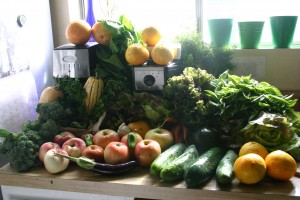
These days there’s a lot of talk about food localism: the practice of eating food that was grown close to where you eat. Enthusiasts of the movement often try to make their meals only out of food grown within 200 miles of where they live.
If I did that, I’d be without my two (okay, three!) cups of coffee every morning, but I admit that I see the appeal. I’m lucky enough to live in a region with community-supported agriculture (or “CSA”) groups, which means that our family largely eats produce that was grown only miles from where we live.
But families in the Regency took local eating to a whole new level, especially in the large country estates. These estates, formed hundreds of years before there were safe and reliable roads and trade routes, grew almost all of their own food out of necessity, and even in the Regency, when importing food was more feasible, many of these large estates still produced most of what they ate right there on the property.
What kinds of foods were produced on a country estate?
The food produced on an English country estate ran the gamut from meat to vegetables, wheat to fruit, dairy to game.
Estates supported large farms, which could grow grains and vegetables in their fields, while the more well-off landowners could also support greenhouses dedicated to expensive and rare tropical fruit like pineapples (a princely gift in those times!). Wheat was made into bread and also used for brewing beer.
Estates also were hugely concerned with animal husbandry. Cows provided the milk for on-the-grounds dairies, and they also provided meat, along with pigs and sheep. There were even estates with dovecotes that raised pigeons for the table – the nestlings, or “squabs”, were prized for their delicate meat. Large estates could also contain fishponds.
The extraordinary thing to modern eyes was not necessarily how much food was produced in the lands surrounding the great English houses, but how much of the processing of that food was done on the property. Nowadays, farms grow food and factories process them. But in the 1800s, the growing and processing was often done on the same property, with the cows being milked, the dairymaid making cheese, and the cook arranging the cheese dish all being owned or employed by the same family.
Further Reading
For a much more thorough overview of the food production and processing on an English estate, I recommend Christina Hardyment’s “Behind the Scenes: Domestic Arrangements in Historic Houses”.
And for a fascinating look at current localism, I recommend Barbara Kingsolver’s “Animal, Vegetable, Miracle”.
Peace of Christ to you,
Originally posted 2012-08-27 10:00:00.
Comments are closed.